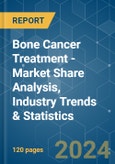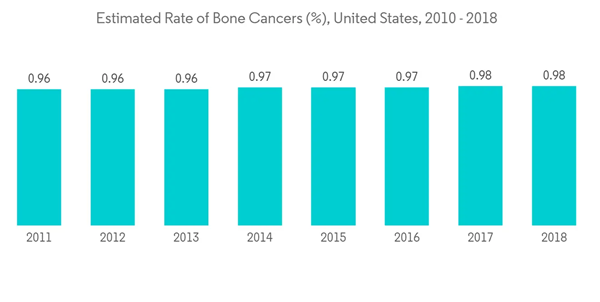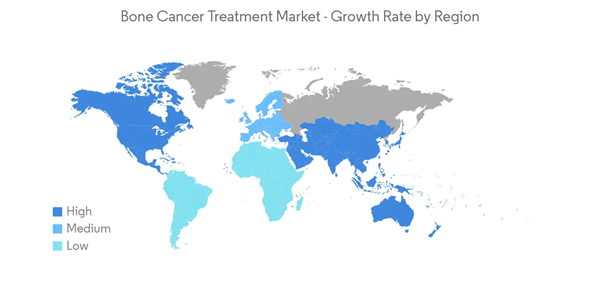The Bone Cancer Treatment Market size is estimated at USD 1.22 billion in 2024, and is expected to reach USD 1.58 billion by 2029, growing at a CAGR of 5.27% during the forecast period (2024-2029).
During the early stages of COVID-19, there was a significant reduction in the number of cases treated in the musculoskeletal oncology departments, which has affected the number of surgical volumes. The massive reduction in musculoskeletal oncology services may have drastic consequences for affected patients and the overall market growth. However, several precautionary guidelines were issued by the respective government authorities to initiate the delayed or postponed bone cancer treatments, enabling patients to acquire safe access to treatment during the COVID-19 pandemic.
Certain factors driving the market growth include the increasing global burden of bone cancer and government initiatives for bone cancer awareness. The incidence of bone cancer is on a steady rise and needs to be addressed at the earliest to reduce the burden of bone sarcoma across the world.
According to estimates by the American Society of Clinical Oncology, the United States is estimated to witness 3,610 new cases of bone cancer and an expected 2,060 deaths due to bone cancer in 2021. The chemotherapeutic drugs approved for the treatment of bone cancer do not have an effective treatment regime, as it always varies according to the prevailing conditions and the way the patient's body responds to the drug. Hence, the associated side effects, risks, and limitations of the treatment are limiting the growth of the bone cancer treatment drug market.
Osteosarcoma is the most common type of cancer affecting the bones, and it mostly occurs in children and young adults. Based on the cells, osteosarcoma is classified as high-, intermediate-, and low-grade. According to the American Cancer Society, 2019, about 800 to 900 new cases of osteosarcoma are diagnosed in the United States every year, with about half of these occurring in children and teenagers.
Research on osteosarcoma is done at various medical centers, university hospitals, and other institutions across the world. Many advancements have taken place in the treatment of osteosarcoma in the past few decades. Osteosarcoma can be treated by surgery, radiation therapy, chemotherapy, targeted therapy drugs, etc.
Thus, research related to the bone cancer treatment market is increasing, owing to the high prevalence of osteosarcoma globally.
North America currently dominates the bone cancer treatment market, and it is expected to continue its stronghold for a few more years. According to the American Cancer Society estimates for 2022, around 3,910 new cases will be diagnosed, along with 2,100 deaths, due to bone cancer. The same source stated that primary bone cancers (cancers that start in the bones) are uncommon, accounting for less than 1% of all cancers. In adults, cancers that spread to the bones from other organs are much more common than primary bone cancers. Osteosarcoma is the most common type of primary bone cancer overall, followed by chondrosarcoma and Ewing sarcomas.
The region is expected to increase its market share in the future, owing to the fact that currently, in the region, mainly in the United States, many clinical trials are underway for bone cancer therapies. Some studies are testing new chemo drugs. Researchers are also looking for new ways to use the existing approved drug portfolio. For instance, doctors are studying whether adding a bisphosphonate called zoledronic acid (Zometa) to the bone cement, which is used in filling the space left after removing a giant cell tumor, may decrease the chances of that tumor returning to that place. In February 2020, Count Me In, a non-profit research initiative, launched the Osteosarcoma Project, a patient-partnered effort that enables people in the United States and Canada who have been affected by osteosarcoma to accelerate research. This is likely to boost the regional market growth over the forecast period.
This product will be delivered within 2 business days.
During the early stages of COVID-19, there was a significant reduction in the number of cases treated in the musculoskeletal oncology departments, which has affected the number of surgical volumes. The massive reduction in musculoskeletal oncology services may have drastic consequences for affected patients and the overall market growth. However, several precautionary guidelines were issued by the respective government authorities to initiate the delayed or postponed bone cancer treatments, enabling patients to acquire safe access to treatment during the COVID-19 pandemic.
Certain factors driving the market growth include the increasing global burden of bone cancer and government initiatives for bone cancer awareness. The incidence of bone cancer is on a steady rise and needs to be addressed at the earliest to reduce the burden of bone sarcoma across the world.
According to estimates by the American Society of Clinical Oncology, the United States is estimated to witness 3,610 new cases of bone cancer and an expected 2,060 deaths due to bone cancer in 2021. The chemotherapeutic drugs approved for the treatment of bone cancer do not have an effective treatment regime, as it always varies according to the prevailing conditions and the way the patient's body responds to the drug. Hence, the associated side effects, risks, and limitations of the treatment are limiting the growth of the bone cancer treatment drug market.
Bone Cancer Treatment Market Trends
Osteosarcoma is Expected to Hold the Largest Share Over the Forecast Period
The COVID-19 pandemic has disrupted surgical procedures, chemotherapy timings, and frequent hospital visits. In addition, a radical change in the osteosarcoma surgical plan was also observed due to the COVID-19 pandemic. In the bone cancer segment of the market, among all primary bone cancers, osteosarcoma is expected to have the largest market size over the forecast period.Osteosarcoma is the most common type of cancer affecting the bones, and it mostly occurs in children and young adults. Based on the cells, osteosarcoma is classified as high-, intermediate-, and low-grade. According to the American Cancer Society, 2019, about 800 to 900 new cases of osteosarcoma are diagnosed in the United States every year, with about half of these occurring in children and teenagers.
Research on osteosarcoma is done at various medical centers, university hospitals, and other institutions across the world. Many advancements have taken place in the treatment of osteosarcoma in the past few decades. Osteosarcoma can be treated by surgery, radiation therapy, chemotherapy, targeted therapy drugs, etc.
Thus, research related to the bone cancer treatment market is increasing, owing to the high prevalence of osteosarcoma globally.
North America Dominates the Market, and It is Expected to do the Same During the Forecast Period
In North America, the COVID-19 pandemic largely affected the US region, which led to disruptions in many surgical procedures. However, currently, the surgical procedures are being carried out with precautionary measures, which will further lead to steady growth of the market.North America currently dominates the bone cancer treatment market, and it is expected to continue its stronghold for a few more years. According to the American Cancer Society estimates for 2022, around 3,910 new cases will be diagnosed, along with 2,100 deaths, due to bone cancer. The same source stated that primary bone cancers (cancers that start in the bones) are uncommon, accounting for less than 1% of all cancers. In adults, cancers that spread to the bones from other organs are much more common than primary bone cancers. Osteosarcoma is the most common type of primary bone cancer overall, followed by chondrosarcoma and Ewing sarcomas.
The region is expected to increase its market share in the future, owing to the fact that currently, in the region, mainly in the United States, many clinical trials are underway for bone cancer therapies. Some studies are testing new chemo drugs. Researchers are also looking for new ways to use the existing approved drug portfolio. For instance, doctors are studying whether adding a bisphosphonate called zoledronic acid (Zometa) to the bone cement, which is used in filling the space left after removing a giant cell tumor, may decrease the chances of that tumor returning to that place. In February 2020, Count Me In, a non-profit research initiative, launched the Osteosarcoma Project, a patient-partnered effort that enables people in the United States and Canada who have been affected by osteosarcoma to accelerate research. This is likely to boost the regional market growth over the forecast period.
Bone Cancer Treatment Industry Overview
The bone cancer treatment market is highly competitive and consists of a considerable number of significant players. All of the existing players in the market are either legacy suppliers of treatment options, like chemotherapy and radiation therapy, or are concentrating on clinical trials for novel bone cancer approaches, including targeted therapy and immunotherapy. Companies like Bayer AG, Amgen, Novartis AG, and Pfizer Inc., among others, are expected to hold substantial shares in the bone cancer treatment market.Additional Benefits:
- The market estimate (ME) sheet in Excel format
- 3 months of analyst support
This product will be delivered within 2 business days.
Table of Contents
1 INTRODUCTION
4 MARKET DYNAMICS
5 MARKET SEGMENTATION (Market Size by Value - USD million)
6 COMPETITIVE LANDSCAPE
Companies Mentioned (Partial List)
A selection of companies mentioned in this report includes, but is not limited to:
- Amgen
- Baxter
- Bayer AG
- Hikma Pharmaceuticals
- Johnson & Johnson
- Novartis AG
- Pfizer Inc.
- Recordati Group
- Takeda Pharmaceutical Company
- Debiopharm
- Eli Lilly and Company
- Atlanthera
- Spectrum Pharmaceuticals Inc.
Methodology

LOADING...










